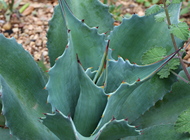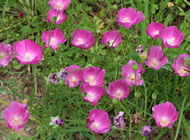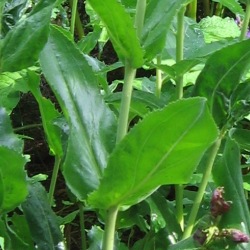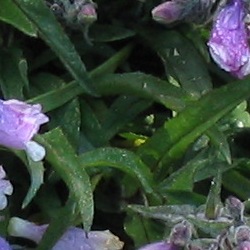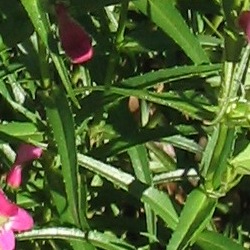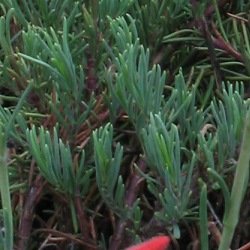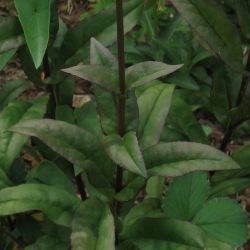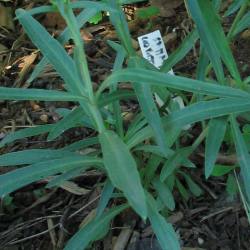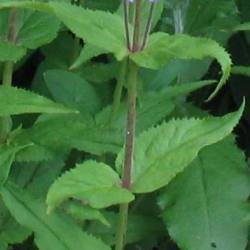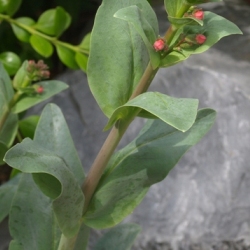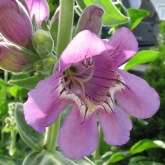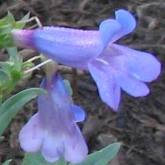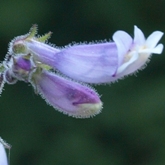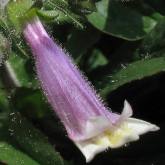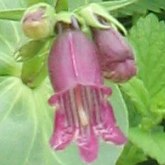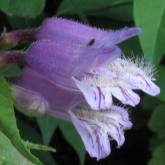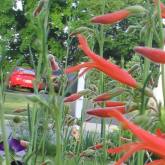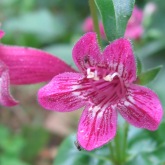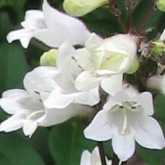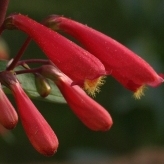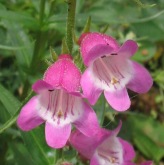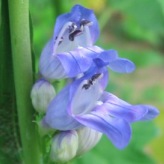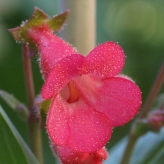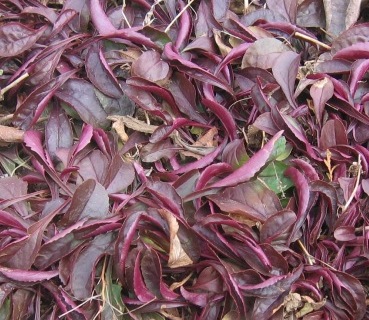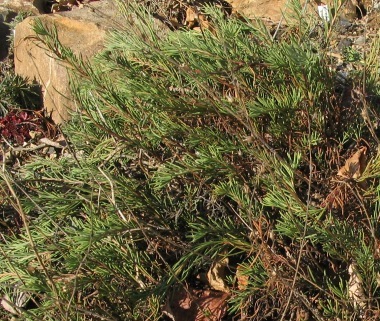The genus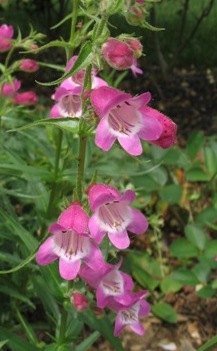
Penstemon — a genus of well over two hundred species, including annuals, biennials, perennials, and subshrubs, all native to North and Central America. They are classified in the plantain family (plantaginaceae), at least that's what the latest version of GRIN says. They used to be classified in scrophulariaceae, but along with the snapdragons (antirrhinum) and foxgloves (digitalis), they've been shipped out. Not that it matters too much which botanical company they hold - the genus is big enough to hold its own. The genus name derives from the Greek words πεντα (penta: five) and στημων (stemon: thread), referring to the five stamens within their flowers (one of which is sterile). The common name describes the fuzzy feature on the bottom lips of the flowers, not unlike the beards in bearded irises. CultivationAs wildflowers, penstemons are widely distributed across North America, making their home in habitats ranging from plains to mountain areas. While some species require more moisture than others, all appreciate well-drained soil, and many insist on it. Full sun is best for most, although some do fine in part shade. Luckily for me, the majority are hardy in our garden in USDA zone 6 (and many can tolerate quite a bit colder climates). A few species have been long-lived for us (P. hirsutus var. pygmaeus and P. pinifolius, for example), but more commonly the plants fade away after a few years, and must be replenished periodically. We've had quite a number of generations of P. strictus by now - but they're nice enough to warrant the effort. PropagationAll of my beard tongue multiplication efforts proceed via seed. I imagine most species can be divided without too much trouble, but for some reason I've never tried. Penstemons aren't always easy to start from seed - germination requirements vary widely from species to species, many requiring cold conditioning and/or light, and often not responding even when "by-the-book" conditions are provided. An extensive overview of penstemon germination requirements (or suggestions) is given at a few pages in Tom Clothier's Garden Walk and Talk website. My own experience is that some species are really quite easy to establish by seed, while others always seem to give trouble during germination, and/or resent the conditions I provide during growing-on in the basement. Still, I germinated enough of 'm that I have some purdy pictures to show on this page. I provide detailed records of my germination attempts on many of the individual species portraits linked from this page. That's only for the ones I've successfully grown, though - for species I never managed to germinate and grow on, I won't bother you with the negative results. Penstemon seeds are angular particles, usually easily extracted from spent flowers. Their color ranges from tan to black. Seed stays viable for a year or two, but loses viability in subsequent years. Interestingly, a penstemon-fanatic seed trading partner told me that very fresh seed often does not germinate well, or has additional germination requirements (cold or light) when fresh, which are no longer required with stored seed. So perhaps year-old seed is best. Beard tongues in the garden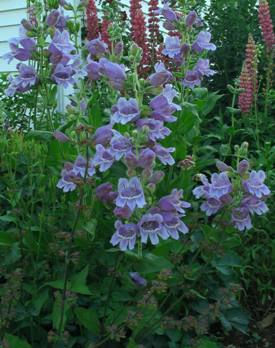
None of the penstemons we grow rise above three feet, and many of them are a good bit shorter than that. Somehow, I don't see them as lending themselves to mass plantings (although I may be wrong!), so in our garden they serve as accents - punctuation marks between plants of larger scales or bigger bulk. Many have an upright, somewhat sparse or lanky habit, working effectively when weaving in with other plants with similar habits but different overall appearance. The bushier ones tend also to be shorter, making good front-of-the-border plants. This of course goes for the truly diminutive P. hirsutus var. pygmaeus, but also holds for P. smallii. The best place for many penstemons is probably not in a traditional border, but in the rock garden. That's where our P. pinifolius lives, but would also be a better station for others we've grown and lost - especially P. heterophyllus, which always seemed a bit lost in a regular garden setting. The leavesPenstemon foliage varies quite a bit in shape, color, and habit. Leaves are oppositely arranged, and as far as I know always undivided. Extremes vary from needle-shaped leaves to rounded and lax, from glossy to mat, from toothed to entire. A few examples are shown below.
FlowersLeaves are all good and well, but I don't know anyone who actually grows penstemons for their foliage. This bunch packs its primary punch in bloom! Although the basic features of the flowers in the genus are the same, there's plenty of variety:
In winterMost penstemons in our garden are squarely in the deciduous corner - not
much to look at during the cold months. But a few species continue to provide
interest through winter. The two photos below show examples:
Other speciesA seed trader this year tempted me to start a whole bunch of new penstemon species. Although I'm sure not all of them will germinate, and of those that do not all will survive their first year, I still hope to have plenty more varieties to add to this page soon. Stay tuned! Further readingA useful link collection is provided in the Open Directory Project's penstemon category . You'll find an extensive list of species with identification information on the website of the American Penstemon Society. Visitors to this page have left the following comments
I welcome comments about my web pages; feel free to use the form below to leave feedback about this particular page. For the benefit of other visitors to these pages, I will list any relevant comments you leave, and if appropriate, I will update my page to correct mis-information. Note that I discard any comments including html markups, so please submit your comment as plain text. If you have a comment about the website as a whole, please leave it in my guestbook. If you have a question that needs a personal response, please e-mail me.
Last modified:
May 27, 2015 |
||||||||||||||||||||||||||||||||||||||||||||||||||||||||||||||||||||||||||||||||||||||||||||||||||||||
